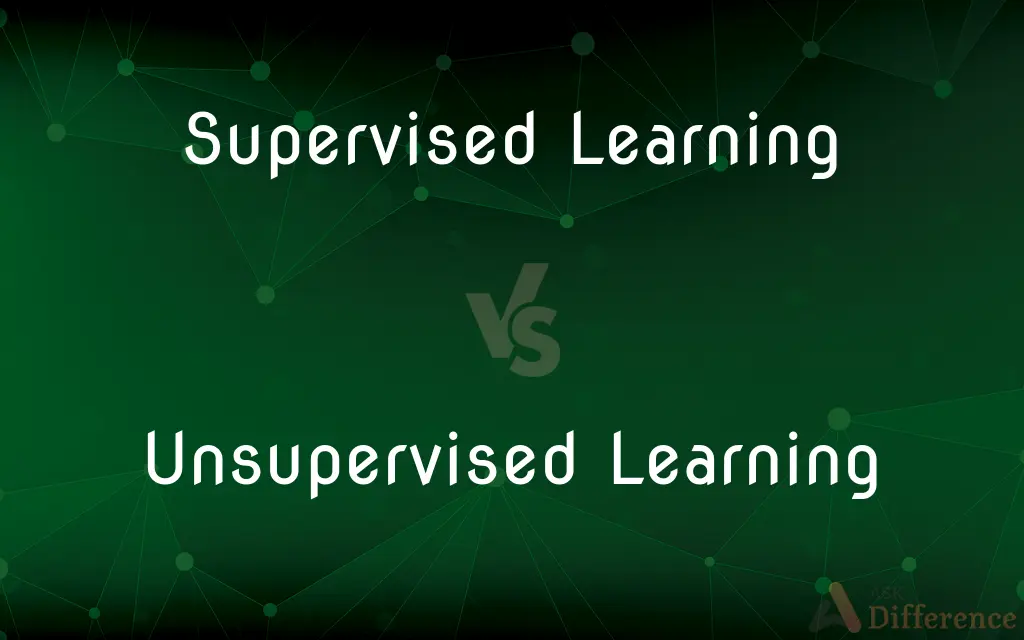Supervised Learning vs. Unsupervised Learning — What's the Difference?
By Tayyaba Rehman — Published on January 2, 2024
Supervised learning uses labeled data for training, while unsupervised learning finds patterns in unlabeled data.

Difference Between Supervised Learning and Unsupervised Learning
Table of Contents
ADVERTISEMENT
Key Differences
Supervised learning algorithms are trained using labeled data, meaning the input data is tagged with the correct output. In unsupervised learning, the system tries to learn the patterns and the structure from the data without pre-existing labels. Supervised learning models are used for prediction based on known properties learned from the training set, while unsupervised learning is used for exploring data structure and distribution.
Supervised learning requires human intervention to label data, which can be time-consuming and expensive. Unsupervised learning, however, does not need labeled data, which can make it more applicable to a broader range of data analysis scenarios where labeling is impractical. Supervised learning is typically used for tasks such as classification and regression, whereas unsupervised learning is used for clustering, association, and dimensionality reduction.
The process of training a supervised learning algorithm involves optimizing model parameters to best map inputs to known outputs. Conversely, unsupervised learning algorithms focus on identifying patterns and correlations in the input data without reference to known outcomes. Supervised learning models are evaluated based on their accuracy in predicting the correct labels, while unsupervised models might be assessed on how well they capture the inherent structure or distribution of the data.
Supervised learning often requires a large amount of data to train effectively and avoid overfitting. Unsupervised learning can sometimes work with less data but may produce less precise or interpretable results. Supervised learning's results are generally easier to evaluate since the true outcomes are known, but unsupervised learning outcomes can be more subjective and harder to assess.
Comparison Chart
Data Labeling
Requires labeled data
Works with unlabeled data
ADVERTISEMENT
Learning Task
Classification, regression
Clustering, association, dimensionality reduction
Human Intervention
High (for labeling data)
Low
Model Evaluation
Accuracy, precision, recall
Cluster validity, model fit
Example Applications
Spam filtering, stock price prediction
Market segmentation, genetic clustering
Compare with Definitions
Supervised Learning
Using tagged examples to predict outcomes.
Supervised learning enables a program to recognize cats in pictures by learning from labeled images.
Unsupervised Learning
Grouping data by similarities.
The algorithm uses unsupervised learning to cluster genes with similar expression patterns.
Supervised Learning
Focused on prediction accuracy.
Supervised learning is employed to enhance the precision of facial recognition software.
Unsupervised Learning
Discovering hidden correlations.
Through unsupervised learning, the model reveals correlations between different market indicators.
Supervised Learning
Training models on labeled data.
In supervised learning, a spam filter is trained with emails marked as 'spam' or 'not spam.'
Unsupervised Learning
Learning without explicit instructions.
Unsupervised learning algorithms can identify fraudulent activity by detecting unusual patterns.
Supervised Learning
Mapping input to known outputs.
Using supervised learning, the system accurately predicts weather patterns from historical data.
Unsupervised Learning
Inferring data structure autonomously.
Unsupervised learning helps a program understand topic distribution in a corpus of text.
Supervised Learning
Learning with a teacher.
In supervised learning, the algorithm improves its accuracy over time through feedback.
Unsupervised Learning
Finding patterns in data without labels.
Unsupervised learning is used to segment customers into groups based on purchasing behavior.
Common Curiosities
What is the main challenge in supervised learning?
Obtaining a large, diverse set of labeled data can be difficult and expensive.
What is supervised learning?
Supervised learning involves training models with labeled data to predict outcomes.
Is unsupervised learning always better for large datasets?
Not necessarily; it depends on the dataset's nature and the desired outcome.
Can unsupervised learning predict specific outcomes?
No, it's more about discovering data structure rather than predicting.
Can unsupervised learning handle complex data?
Yes, it's good for complex data where the relationships are not clearly defined.
Do supervised learning models require more data than unsupervised?
Typically, yes, to avoid overfitting and improve model generalization.
What is unsupervised learning?
Unsupervised learning discovers patterns in unlabeled data without guidance.
When is supervised learning used?
It's used when labeled data is available for training, like in classification tasks.
Is supervised learning easier to understand than unsupervised?
Yes, because the outcomes and objectives are more clearly defined.
How do you evaluate a supervised learning model?
Through metrics like accuracy, precision, and recall against known labeled data.
What's a common use of unsupervised learning?
Common uses include customer segmentation and anomaly detection.
Can unsupervised learning techniques handle labeled data?
Yes, but they typically do not utilize the labels in the learning process.
What's an example of a supervised learning algorithm?
Decision trees, support vector machines, and neural networks.
What's an example of an unsupervised learning algorithm?
K-means clustering and hierarchical clustering.
Can supervised learning methods be used for data exploration?
They are not typically used for exploration but rather for making predictions based on labeled data.
Share Your Discovery

Previous Comparison
Innate Immunity vs. Acquired Immunity
Next Comparison
Distance Vector Routing vs. Link State RoutingAuthor Spotlight
Written by
Tayyaba RehmanTayyaba Rehman is a distinguished writer, currently serving as a primary contributor to askdifference.com. As a researcher in semantics and etymology, Tayyaba's passion for the complexity of languages and their distinctions has found a perfect home on the platform. Tayyaba delves into the intricacies of language, distinguishing between commonly confused words and phrases, thereby providing clarity for readers worldwide.
















































